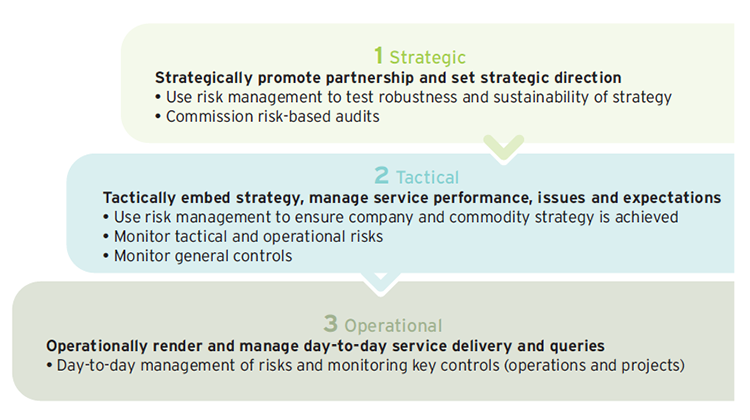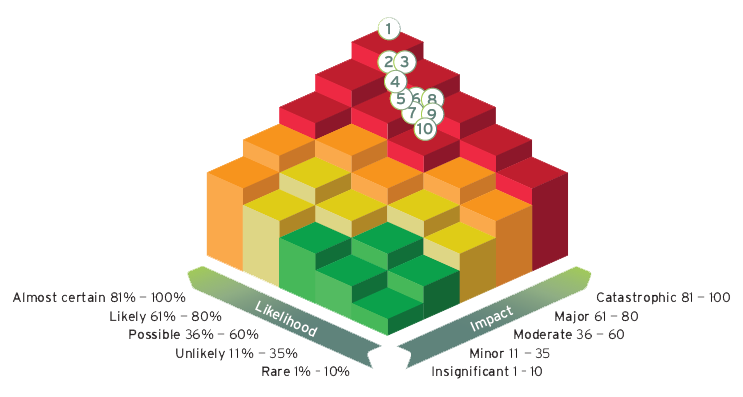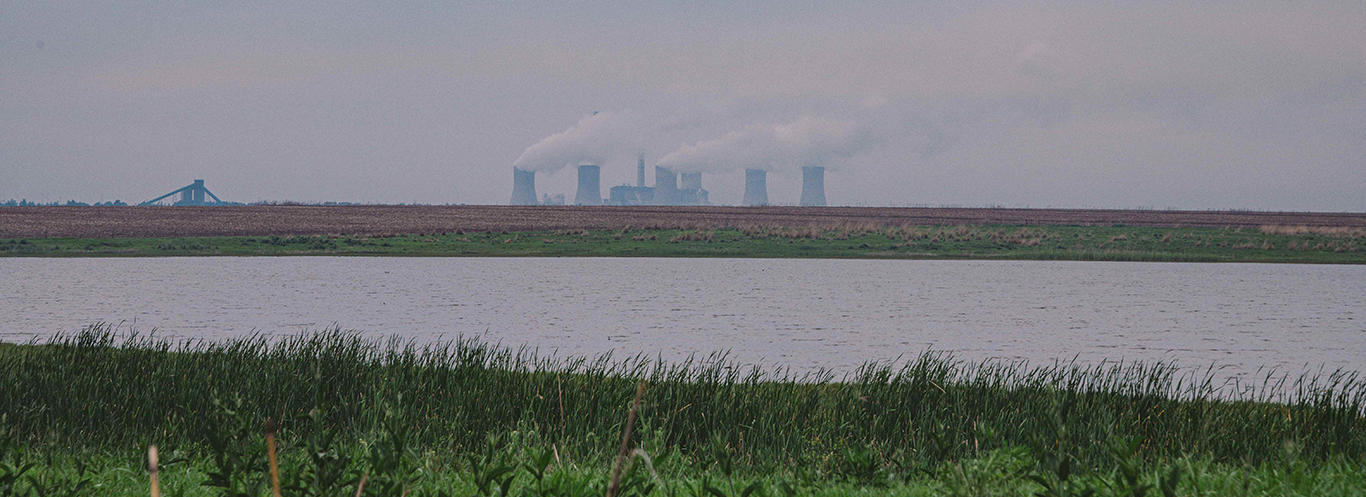The mining industry has faced numerous challenges in the last three years. In an uncertain and volatile environment, we rely on our mature risk management strategies to make agile and effective decisions to mitigate risk exposure and leverage opportunities.
In a volatile political and economic environment characterised by change and uncertainty, risk management is a critical success factor for us to achieve strategic and business objectives to remain sustainable and protect shareholder value. Embedding risk management into our daily activities and processes is key to making informed decisions and proactively planning for possible future unwanted events stemming from internal and external sources.
Our enterprise risk management (ERM) process is a strategic initiative fully supported by the board and executive management. The ERM framework provides a proactive, systematic and integrated approach to risk management. The principles outlined in the framework form the foundation for our risk management philosophy, mission and vision. The ERM framework and process illustrated below are based on principles published by the Committee of Sponsoring Organisations of the Treadway Commission, the ISO 31000 international guideline on risk management and King IV. It also considered applicable codes of best practice such as ISO 9001, 14001 and 18001. The ERM framework is regularly reviewed to ensure it remains relevant and effective.
Environment (internal and external)

We follow a cascade approach by identifying risk events at the organisation's strategic, tactical and operational layers. Significant risks from the strategic layer are filtered down to the tactical and operational layers and are supplemented by the identification of risks that have an impact across the organisation. Significant risks originating at an operational layer will also be elevated to a strategic or tactical layer if the residual risk and residual risk gap exceed certain thresholds. In this way, the process incorporates a top-down/bottom-up view of risks within the organisation.

Exxaro's risk management philosophy identifies risk management as a strategic enabler rather than being compliance-driven. This ensures that we think and act proactively at every layer to pursue the company's strategic objectives.
The board and executive committee monitor KPIs quarterly to ensure all risks and key metrics are within Exxaro's risk appetite. The risk appetite framework is updated annually or when deemed necessary as part of the strategic planning process.

| Performance against our strategy and future focus |
We use the ERM framework to identify and realise opportunities – for example, early value coal extraction to maximise value in the short to medium term in view of the climate change risk. We believe that, for Exxaro to remain sustainable in the short term, it is important to adapt the minerals business to change and identify and pursue possible opportunities that ultimately create value, such as reducing stranded high-value Coal Reserve risk.
The opportunities we identified in 2022 informed our Sustainable Growth and Impact strategy.
| Opportunity | Strategic objective |
| The drive for future-facing minerals presents opportunities to invest in exploration projects at various stages through our balanced portfolio approach towards capital allocation and managing risk and returns | Transition at speed and scale |
| Private-public participation in local rail operations is an opportunity for value unlock and vertical integration. We are currently investigating this opportunity | Make our minerals and energy businesses thrive |
| The multidimensional poverty index highlights the drivers of poverty and inequality in our communities, allowing us to focus our social impact efforts towards sustainable impact. We will focus on education, land use and local economic development | Become a catalyst for economic growth and environmental stewardship |
| The early value coal strategy and our ability to maximise resource to market opportunities by leveraging the low cost and flexibility of our coal assets and reserves | Make our minerals and energy businesses thrive |
| Accelerated expansion into renewable energy will support our low-carbon transition | Be carbon neutral by 2050 Make our minerals and energy businesses thrive |
| Impact investments provide an opportunity for Exxaro to leverage this financing market to support our just transition ambitions and align with our Sustainable Growth and Impact strategy | Empower people to create impact |
| The hydrogen economy was identified as a strengthening signal through our foresight process and market analysis conducted in 2021. Following this analysis, we concluded that hydrogen provides tailwind opportunities for our energy business and is not of significant interest to necessitate a horizon 2 shift at this stage | Make our minerals and energy businesses thrive |
| Nature-based solutions to mitigate the impacts of climate change were identified as an opportunity, especially in lieu of the vast amount of viable land that Exxaro has at our disposal. We intend to maximise this opportunity through our Sustainable Growth and Impact strategy | Be carbon neutral by 2050 |
Investing in self-generation facilities is an opportunity we are leveraging, which aligns with our renewable energy growth strategy. Exxaro will develop a 68MW photovoltaic farm, near Grootegeluk, through its SPV, Lephalale Solar Proprietary Limited. This is our first self-generation project to expand and diversify within the renewable energy space, supporting low-carbon emissions, and long-term savings on electricity usage at Grootegeluk |
Make our minerals and energy businesses thriveBe carbon neutral by 2050 |
| The global energy transition provides an opportunity to mine and supply the minerals that support green technologies. Through a rigorous screening process, Exxaro identified copper, manganese and bauxite as being most aligned to our experience, capabilities and market forecast | Make our minerals and energy businesses thrive |
The trend report indicates changes in the residual risk score when comparing the 2022 and 2023 financial years. Our risk scores are derived from the product of the likelihood and the impact of the unwanted event*. The top 10 risks are arranged from highest to lowest risk score.
The 2023 ranking represents the key possible unwanted events we anticipate having a potential impact on our ability to achieve our strategic imperatives in 2023. These risks are reviewed on a quarterly basis and could change significantly depending on the internal and external root causes that drive these risks to materialise. These risks are prioritised and treatment strategies have been designed and implemented. The effectiveness of these treatments will be monitored on an ongoing basis to ensure the risks are managed down to acceptable risk levels.
| 2022 top risks | Ranking | 2023 top risks (forward-looking) | Ranking in top 10 trend | Comments |
| Unavailability of rail capacity | 1 | Unavailability of rail capacity |  |
TFR productivity remains a new challenge. Closing the gap initiatives implemented to reduce impact of TFR performance on exports (other optionalities and Free Carrier sales). High level engagements with TFR continue with view to find solutions to current challenges and improve train availability. |
| Eskom systemic risk | 2 | Key dependency on Eskom as a key customer |  |
The utility continues to have operational challenges. Some of the challenges experienced by Eskom require additional funding which will place the utility under financial strain. |
| Community unrest | 3 | Cybersecurity attacks impacting business |  |
The risk of cyberattacks remains high. Following an incident in October 2022 and the outstanding items on the cybersecurity score, a comprehensive list of actions was compiled to lower the residual risk. There are two categories of actions: (a) actions from the forensic report received from the Microsoft Detection and Response Team and (b) a list of actions identified internally with service providers. |
| Cybersecurity threats | 4 | Fatal risk incidents |  |
Exxaro's focus will be on our five strategic pillars:
|
| Health and safety concerns | 5 | Not achieving growth objectives |  |
The primary growth lever for the organisation is inorganic growth through acquisition. Possible contributing factors could also include:
|
| Cost competitiveness of products | 6 | Inflationary pressures |  |
Higher than inflation increases in the cost of consumables (eg oil prices, logistical costs, etc) and lower production volumes result into an increase in unit cost. |
| Climate change concerns | 7 | Country risk (geopolitical) |  |
The current political environment, slow economic recovery, deteriorating state infrastructure and other macro-economic factors have an adverse effect on the country risk assessment. |
| Loss of social licence to operate | 8 | Loss of licence to operate |  |
Ongoing monitoring of compliance with specific focus on licence to operate. |
| Unable to secure sufficient insurance cover | 9 | Legal and regulatory non-compliance |  |
Changes to regulatory framework in mining and energy are constantly monitored. Awareness and training on compliance matters are planned for 2023. Ongoing monitoring of legal and regulatory compliance. |
| Country risk (geopolitical) | 10 | Water scarcity (medium to long term) |  |
Additional augmentation of the Mokolo Crocodile Water Augmentation Project (MCWAP) scheme through sourcing additional water from Crocodile River system (MCWAP2) will strengthen the yield of the overall system and alleviate the medium to long-term risk at our Grootegeluk operation. Our Mpumalanga operations are less vulnerable to water scarcity as they have an overall positive water balance. Exxaro will set an internal price of water in 2023 to further drive water conservation awareness at our operations. |
* Risk = f (likelihood of risk occurring x Impact of the risk).
 |
Ranking in the top 10 is higher compared to previous year |
 |
Ranking in the top 10 remained unchanged compared to previous year |
 |
Ranking in the top 10 reduced compared to previous year |
Exxaro's top 10 risks are plotted inherently (before controls) and residually (after controls) on the heat maps below, followed by an outline of our key identified risks, the main drivers, their potential impacts and mitigating treatments. We have considered internal and external risks. Our mitigation strategies depend on the severity of impact and likelihood of occurrence.


Various risk treatment strategies are evaluated, including risk avoidance, reduction, sharing, acceptance or transferring. When selecting risk treatment options, we consider the values and perceptions of stakeholders and the most appropriate ways to communicate them.
The decision to implement a treatment is based on risk tolerances, the effect the treatment will have on the impact and likelihood ratings, and the results of the cost versus benefit evaluation. Once a risk treatment is implemented, Exxaro develops ongoing mechanisms to monitor the implementation and effectiveness of the risk treatment.
| Lines of defence | |
| 1 | Management of risk (risk owner) |
| 2 | Management support and oversight |
| 3 | Independent assurance |
| Risk trend | |
 |
Residual risk increased compared to previous year |
 |
Residual risk decreased compared to previous year |
 |
Residual risk remained unchanged compared to previous year |
 |
New |
| 1. Unavailability of rail capacity (2022: 1) | |||
| Drivers | Impacts |
Material theme Capitals impacted Line of defence 1Risk ranking trend 
|
|
|
|
||
| Treatments | Outlook | ||
|
Operational and maintenance challenges are expected to continue to have a significant impact on Exxaro. Sustainable solutions to current challenges will be explored through proactive engagement with Transnet and the industry. | ||
| Strategic KPIs | Strategic objective impacted | ||
|
Make our minerals and energy businesses thrive |
| 2. Key dependency on Eskom as a key customer (2022: 2) | |||
| Drivers | Impacts |
Material theme Capital impacted Lines of defence 1 and 2Risk ranking trend 
|
|
|
|
||
| Treatments | Outlook | ||
|
Eskom's financial challenges will remain a concern in the short to medium term as government continues to reform South Africa's electricity sector and Eskom implements its turnaround strategy and restructuring. | ||
| Strategic KPIs | Strategic objective impacted | ||
|
Make our minerals and energy businesses thrive | ||
| 3. Cybersecurity attacks impacting business (2022: 4) | |||
| Drivers | Impacts |
Material theme Capitals impacted Lines of defence 1, 2 and 3Risk ranking trend 
|
|
|
|
||
| Treatments | Outlook | ||
|
The prevalence of cybersecurity attacks, specifically ransomware the most prevalent, is expected to increase. We will continue to improve the robustness of the cybersecurity posture. Exxaro continues to benchmark its cybersecurity profile to enhance our efforts on vulnerability identification and management. |
||
| Strategic KPIs | Strategic objective impacted | ||
|
|
||
| 4. Fatal risk incidents (2022: 5) | |||
| Drivers | Impacts |
Material theme Capitals impacted Lines of defence 1, 2 and 3Risk ranking trend 
|
|
|
|
||
| Treatments | Outlook | ||
|
Our employees' safety remains a top priority. Although good safety performance (LTIFR) has been demonstrated in the recent past, we continue to implement our safety strategy with a focus on safety improvement in our quest for zero harm. | ||
| Strategic KPIs | Strategic objective impacted | ||
|
Make our minerals and energy businesses thrive | ||
| 5. Not achieving growth strategy (new top 10) | |||
| Drivers | Impacts |
Material themes Capitals impacted Lines of defence 1, 2 and 3Risk ranking trend 
|
|
|
|
||
| Treatments | Outlook | ||
|
The primary growth lever for the organisation is inorganic growth through acquisition. We will continue to pursue opportunities for growth through mergers and acquisitions. | ||
| Strategic KPIs | Strategic objective impacted | ||
|
|
||
| 6. Inflationary pressures (2022: 6) | |||
| Drivers | Impacts |
Material theme Capitals impacted Lines of defence 1, 2 and 3Risk ranking trend 
|
|
|
|
||
| Treatments | Outlook | ||
|
Inflationary pressure is expected to continue given challenges in the global economy exacerbated by the Russia-Ukraine conflict. We continue tracking and monitoring production efficiency initiatives to manage ongoing volatile conditions and cost pressures, focusing on reducing consulting costs and continued focus on production efficiencies. |
||
| Strategic KPIs | Strategic objective impacted | ||
|
Make our minerals and energy businesses thrive | ||
| 7. Country risk (geopolitical) (2022: 10) | |||
| Drivers | Impacts |
Material theme Capitals impacted Line of defence 1Risk ranking trend 
|
|
|
|
||
| Treatments | Outlook | ||
|
Socio-political risks, policy uncertainty and sluggish South African economy are expected to continue influencing this risk. | ||
| Strategic KPIs | Strategic objectives impacted | ||
|
|
||
| 8. Loss of licence to operate (2022: 8) | |||
| Drivers | Impacts |
Material themes Capitals impacted Lines of defence 1, 2 and 3Risk ranking trend 
|
|
|
|
||
| Treatments | Outlook | ||
|
We will continue focusing on delivery of our commitments to our licence to operate. Furthermore, the implementation of the Social Impact strategy is expected to deliver greater impact on the communities where we operate | ||
| Strategic KPIs | Strategic objective impacted | ||
|
Make our minerals and energy businesses thrive |
| 9. Legal and regulatory non-compliance (2022: 12) | |||
| Drivers | Impacts |
Material theme Capitals impacted Lines of defence 1, 2 and 3Risk ranking trend 
|
|
|
|
||
| Treatments | Outlook | ||
|
Changes to regulatory framework in mining and energy are constantly monitored. Ongoing awareness and training on legal and regulatory requirements |
||
| Strategic KPIs | Strategic objective impacted | ||
|
Make our minerals and energy businesses thrive |
| 10. Water scarcity (medium to long term) (2022: 18) | |||
| Drivers | Impacts |
Material themes Capitals impacted Lines of defence 1, 2 and 3Risk ranking trend 
|
|
|
|
||
| Treatments | Outlook | ||
|
Additional augmentation of the MCWAP scheme through sourcing additional water from MCWAP2 will strengthen the yield of the overall system and alleviate the medium to long-term risk at our Grootegeluk operation.Our Mpumalanga operations are less vulnerable to water scarcity as they have an overall positive water balance.Exxaro will set an internal price of water in 2023 to further drive water conservation awareness at our operations | ||
| Strategic KPIs | Strategic objective impacted | ||
|
|
||

Matla pollution control dam
 Report Index
Report Index